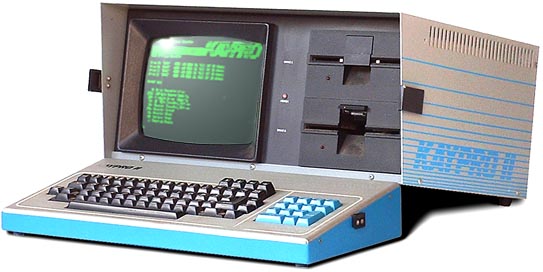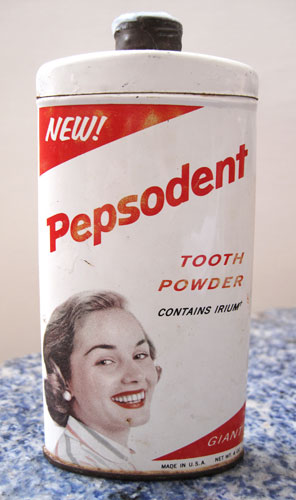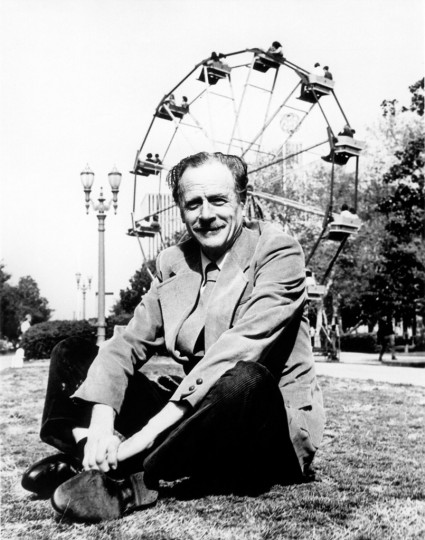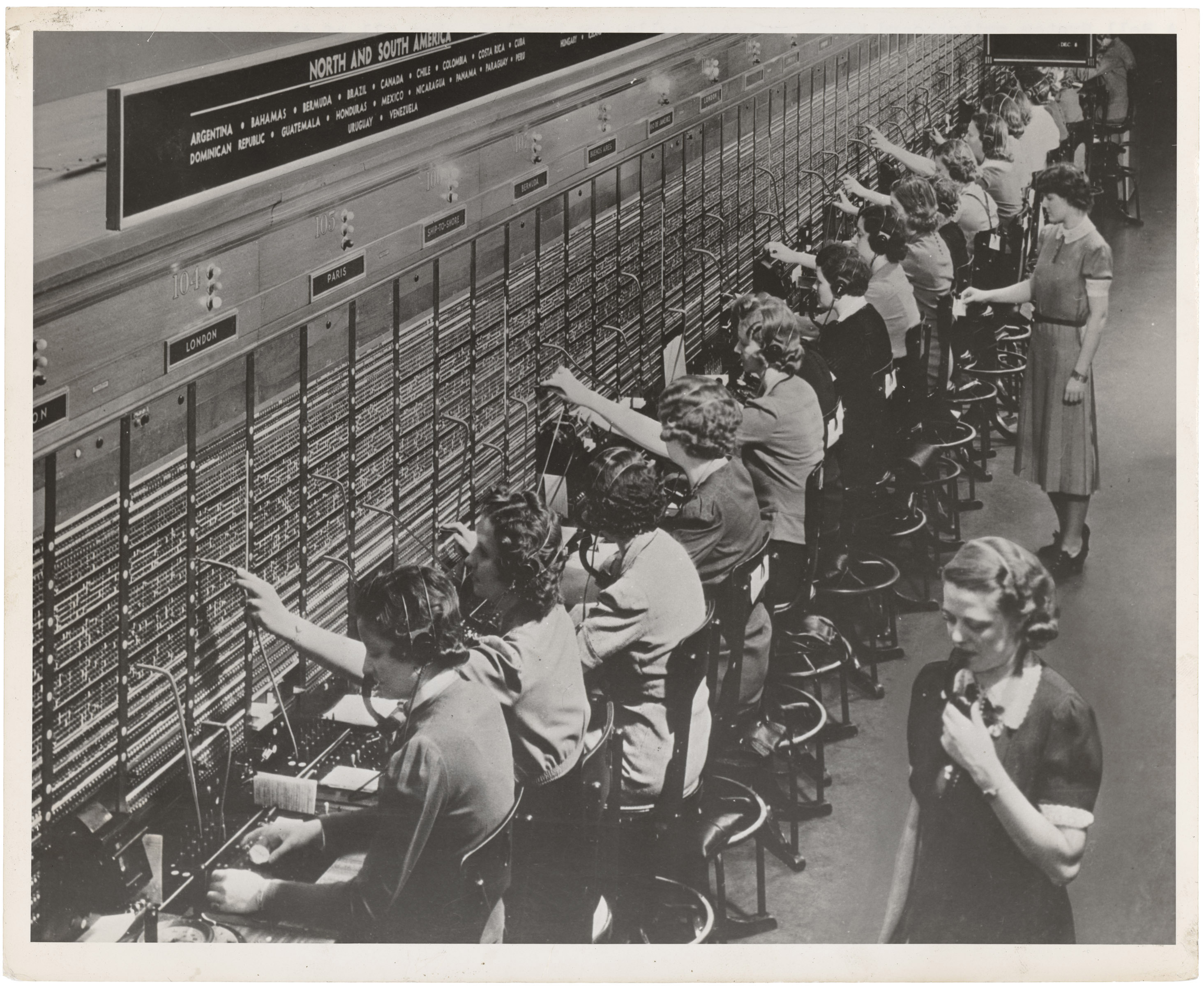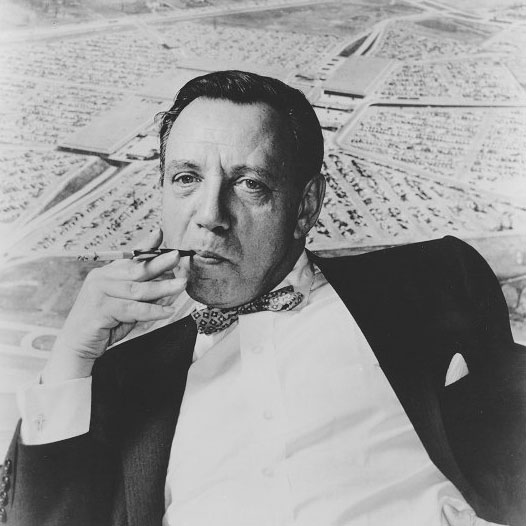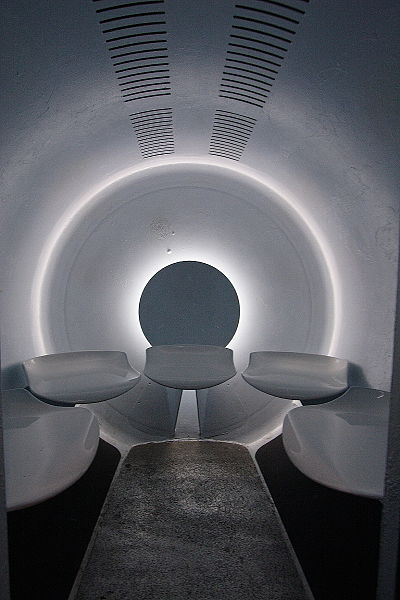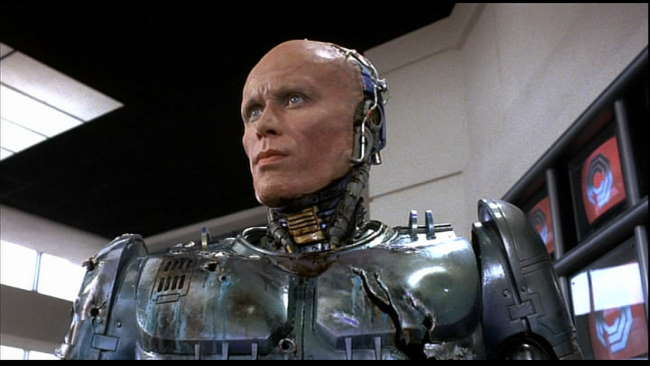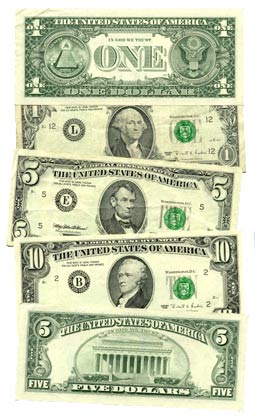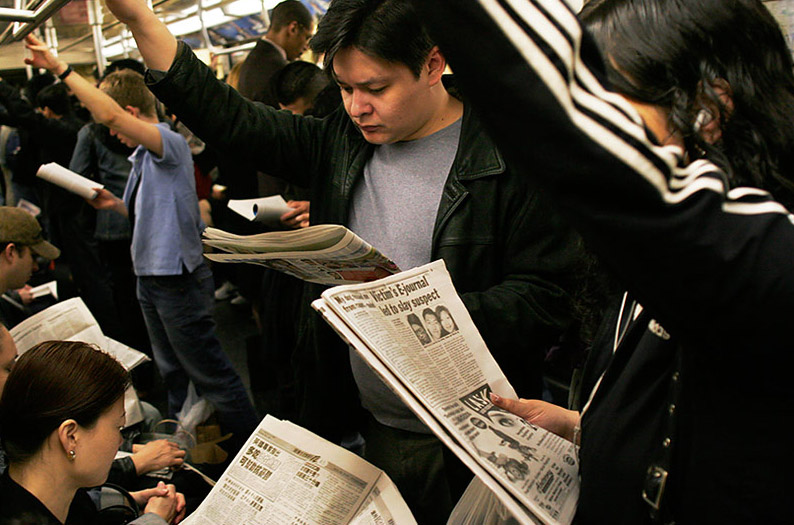Marshall McLuhan and artist and ace typographer Harley Parker enjoy a bull session in 1967’s “Picnic in Space,” which is informed by the work of Warhol, Lichtenstein and Godard.
You are currently browsing the archive for the Science/Tech category.
Tags: Harkey Parker, Marshall McLuhan
Just listened to a fun interview that Bill Simmons did with stats guru Bill James at the MIT Sloan Sports Analytics Conference. I paid close attention to James’ ability to remember names and dates, and like pretty much every informavore I’ve ever encountered, his recall isn’t very good. The memory is just so elastic even for someone who’s brilliant, except for a few anomalies. Interesting that James points out that he was actually aided in his early career in the 1970s by working with numbers in a time before everyone had a computer or two in their pocket. Because collecting and crunching info was so difficult in an unwired world, others interested in sports stats pretty much gave up while James soldiered on. An excerpt from James talking about his first use of computers:
“Bill Simmons: There’s no way you’re using a computer at this time?
Bill James: We didn’t have personal computers, no. Everything was handwritten and in notebooks.
Bill Simmons: When did you move over to the personal computer?
Bill James: I enjoyed personal compyers as soon as they came out–
Bill Simmons: I would have guessed.
Bill James: I never could program or anything like that. We had a Kaypro…I had a spreadsheet on it that was 32 cells long and 16 wide.”
•••••••••
A great 1983 Kaypro commercial by ad legend Joe Sedelmaier:
Tags: Bill James, Bill Simmons, Joe Sedelmaier
In the wake of a devastating earthquake last year, Japanese researchers are experimenting with home levitation. From Popsci: “Instead of building super-strong yet flexible structures to withstand earthquakes, what if you built your house to levitate on a cushion of air? This is already being employed in Japan, a little less than a year after the massive earthquake and tsunami that devastated the country.
The levitation system is the brainchild of a company called Air Danshin Systems Inc., which the Japanese-culture-and-art site Spoon & Tamago says roughly translates to ‘anti-seismic.’ It was founded in 2005 but has caught on after the March 11, 2011 Tohoku earthquake.”
I’ve recently linked to a couple of excellent pieces of Charles Duhigg’s reportage for the New York Times (here and here). He has another impressive article, this one for Slate about the hidden corners of consumerism, called “The Power of Habit.” The opening:
“One day in the early 1900s, a prominent American businessman named Claude C. Hopkins was approached by an old friend with an amazing new creation: a minty, frothy toothpaste named ‘Pepsodent’ that, he promised, was going to be huge.
Hopkins, at the time, was one of the nation’s most famous advertising executives. He was the ad man who had convinced Americans to buy Schlitz beer by boasting that the company cleaned their bottles ‘with live steam’ (while neglecting to mention that every other company used the same method). He had seduced millions of women into purchasing Palmolive soap by proclaiming that Cleopatra had washed with it, despite the sputtering protests of outraged historians.
But Hopkins’ greatest contribution would be helping to create a national toothbrushing habit. Before Pepsodent, almost no Americans brushed their teeth. A decade after Hopkins’ advertising campaigns, pollsters found that toothbrushing had become a daily ritual for more than half the population. Everyone from Shirley Temple to Clark Gable eventually bragged about a ‘Pepsodent smile.”
••••••••
Steve and Eydie don’t have filthy, scummy teeth, 1978:
Tags: Charles Duhigg, Claude C. Hopkins
From Wired: “The robot on display in the video above is being developed by DARPA, the Pentagon’s blue-sky research agency, as part of their Autonomous Robotic Manipulation (ARM) program. Launched in 2010, the initiative aims to come up with robots that can perform highly complex tasks (bomb dismantling, for one) with very little human input.”
Marshall McLuhan watching the tube, urging us to drown out the white noise, to observe more closely.
Tags: Marshall McLuhan
Researchers in Japan have developed a handgun that can literally stop people from talking in mid-sentence. It has scary Big Brother applications, obviously, though speech today relies more on opposable thumbs than vocal cords. From Extreme Tech:
“Japanese researchers have created a hand-held gun that can jam the words of speakers who are more than 30 meters (100ft) away. The gun has two purposes, according to the researchers: At its most basic, this gun could be used in libraries and other quiet spaces to stop people from speaking — but its second application is a lot more chilling.
The researchers were looking for a way to stop ‘louder, stronger’ voices from saying more than their fair share in conversation. The paper reads: ‘We have to establish and obey rules for proper turn-taking when speaking. However, some people tend to lengthen their turns or deliberately interrupt other people when it is their turn in order to establish their presence rather than achieve more fruitful discussions. Furthermore, some people tend to jeer at speakers to invalidate their speech.’ In other words, this speech-jamming gun was built to enforce ‘proper’ conversations.'”
Janelle Nanos has a timely article, “So Appy Together,” in Boston Magazine, which asks whether smartphones are fundamentally changing what it means to be human. The short answer is “yes.” Until we figure out how to safely use biotech to make our memories more elastic than they naturally are, we need strategies and processes and tools to manage data overload. If you read this blog very much, you know that I think the net gain from these tools far outweighs any negative, but with utility comes dependency–perhaps even a sort of control. An excerpt from Nanos’ piece:
“I LOVE MY SMARTPHONE. It’s become a second brain in my pocket that’s changed how I process information. It’s with me every waking moment — and the sleeping moments, too — tracking my daily habits. And through my constant e-mail and Facebook activity, and the personal documentation of my life via Twitter and Instagram photos, it’s become the lens through which I see the world. All day long, I find myself instinctively reaching for my phone, using it as a tool to validate my existence.
But lately, my smartphone and I have taken our relationship to the next level. I provide it with ever-more-intimate details about my life. Last year, for example, I set a few goals for myself. I wanted to lose some weight, save money, and run a half marathon. With only a few app downloads, my phone became a trainer, life coach, and confidant. It now knows what I eat, how I sleep, how much I spend, how much I weigh, and how many calories I burn (or don’t) at the gym each day. It’s gotten to the point where my phone now somehow knows more about me than anyone else in the world, including my own darling husband. My gadget has become a tiny black mirror, reflecting back how I see myself. Which means things are getting more complicated between us.” (Thanks Browser.)
Tags: Janelle Nanos
In 1967, Professor David F. James visited I’ve Got a Secret for a demonstration.
Tags: David F. James
From “An Uneasy Spy Inside 1970s Suburbia,” one of a series of retrospective 2010 articles in the Los Angeles Times about Philip K. Dick, who speeded to his death with the help of amphetamines, but not before decoding our future:
“During his last few years, when he became financially stable for one of the rare times in his life, his daughters visited him at the Santa Ana apartment he moved to after the implosion of his marriage. Dick’s oldest child, daughter Laura, born in 1960, recalls his place full of Bibles, encyclopedias – Dick was a ferocious autodidact – and recordings of Wagner operas.
Phil’s second daughter Isolde, now 42, visited enough during this period to get to know her father for the first time. She recalls him as working hard to be a good father and struggling to overcome his limitations, both with and without success.
During one visit, he got Isa excited about a trip to Disneyland, then open past midnight. ‘He said, ‘We’re gonna go and stay ‘til it closes!’ But in my mind we were there for only 20 or 30 minutes before he said, ‘Honey, my back’s really hurting.’ I think he was just overwhelmed by all the crowds. I knew him, and knew he was uncomfortable moving outside his comfort zone.’
He spent more of his time walking from the apartment to a nearby Trader Joe’s to get sandwiches, a park where he and Isa tried awkwardly to play kickball, and an Episcopalian church where he had running theological discussions with the clergy.
He’d bought himself a Fiat sports car, but almost never drove, telling Isa, ‘Honey, I’m just so excited to see you, I’m too excited to drive.’ She learned quickly to read her father’s code, which seemed designed to protect her from ugly realities.
Sometimes he’d stay up all night, leaving his visitors laughing for hours as he spun idea after idea, or wrote, in a blaze, until dawn. ‘He could go from that really engaging personality to being withdrawn and closed off,’ Isa remembered, explaining that he would sometimes cancel visits at the last minute. ‘I could tell when we spoke on the phone his voice would go really low and flat. When he had that tone he was depressed. He’d say something like he had the flu. ‘The flu’ was usually his code.'”
Tags: Philip K. Dick
From “The Terrazzo Jungle,” Malcolm Gladwell’s great 2004 New Yorker article about the birth of the mall, long before anyone could imagine many of them becoming ghosts or virtual:
“Victor Gruen was short, stout, and unstoppable, with a wild head of hair and eyebrows like unpruned hedgerows. According to a profile in Fortune (and people loved to profile Victor Gruen), he was a ‘torrential talker with eyes as bright as mica and a mind as fast as mercury.’ In the office, he was famous for keeping two or three secretaries working full time, as he moved from one to the next, dictating non-stop in his thick Viennese accent. He grew up in the well-to-do world of prewar Jewish Vienna, studying architecture at the Vienna Academy of Fine Arts—the same school that, a few years previously, had turned down a fledgling artist named Adolf Hitler. At night, he performed satirical cabaret theatre in smoke-filled cafés. He emigrated in 1938, the same week as Freud, when one of his theatre friends dressed up as a Nazi Storm Trooper and drove him and his wife to the airport. They took the first plane they could catch to Zurich, made their way to England, and then boarded the S.S. Statendam for New York, landing, as Gruen later remembered, ‘with an architect’s degree, eight dollars, and no English.’ On the voyage over, he was told by an American to set his sights high—’don’t try to wash dishes or be a waiter, we have millions of them’—but Gruen scarcely needed the advice. He got together with some other German émigrés and formed the Refugee Artists Group. George S. Kaufman’s wife was their biggest fan. Richard Rodgers and Al Jolson gave them money. Irving Berlin helped them with their music. Gruen got on the train to Princeton and came back with a letter of recommendation from Albert Einstein. By the summer of 1939, the group was on Broadway, playing eleven weeks at the Music Box. Then, as M. Jeffrey Hartwick recounts in Mall Maker, his new biography of Gruen, one day he went for a walk in midtown and ran into an old friend from Vienna, Ludwig Lederer, who wanted to open a leather-goods boutique on Fifth Avenue. Victor agreed to design it, and the result was a revolutionary storefront, with a kind of mini-arcade in the entranceway, roughly seventeen by fifteen feet: six exquisite glass cases, spotlights, and faux marble, with green corrugated glass on the ceiling. It was a ‘customer trap.’ This was a brand-new idea in American retail design, particularly on Fifth Avenue, where all the carriage-trade storefronts were flush with the street. The critics raved. Gruen designed Ciro’s on Fifth Avenue, Steckler’s on Broadway, Paris Decorators on the Bronx Concourse, and eleven branches of the California clothing chain Grayson’s. In the early fifties, he designed an outdoor shopping center called Northland outside Detroit for J. L. Hudson’s. It covered a hundred and sixty-three acres and had nearly ten thousand parking spaces. This was little more than a decade and a half since he stepped off the boat, and when Gruen watched the bulldozers break ground he turned to his partner and said, ‘My God but we’ve got a lot of nerve.'” (Thanks TETW.)
••••••••••
Gruen commissioned this 1968 film about the revitalization of Fresno and the building of the Fulton Mall:
Tags: Malcolm Gladwell, Victor Gruen
I’m assuming better options for civilian space travel will come along before 2050 when Japan is planning on opening its Elevator Into Space, but here’s a bit about it from CNET:
“Japanese construction company Obayashi wants to build an elevator to space and transport passengers to a station about a tenth the distance to the moon.
The elevator would use super-strong carbon nanotubes in its cables and could be ready as early as 2050, according to Tokyo-based Obayashi.
The cables would stretch some 60,000 miles, about a quarter the distance to the moon, and would be attached to Earth at a spaceport anchored to the ocean floor. The other end would dangle a counterweight in space.
The elevator would zip along at 125 mph, possibly powered by magnetic linear motors, but would take about a week to get to the station. It would carry up to 30 people.”
•••••••••••
Philo T. Farnsworth, the Utah-born whiz kid who was hugely responsible for the creation of television, appearing on the medium he helped birth, on I’ve Got a Secret, in 1957. It may seem odd that someone who did something so monumental could appear to be anonymous on the show, but Farnsworth wasn’t widely known for his invention during his life. Even though the architecture of the medium has morphed wildly in the last two decades, we still watch his magic picture box in one form or another.
Tags: Philo T. Farnsworth
From “What Defines a Meme?” James Gleick’s great 2011 Smithsonian article, a section about French scientist Jacques Monod’s prescient, pre-PC ideas about the organic spread of information:
“Jacques Monod, the Parisian biologist who shared a Nobel Prize in 1965 for working out the role of messenger RNA in the transfer of genetic information, proposed an analogy: just as the biosphere stands above the world of nonliving matter, so an ‘abstract kingdom’ rises above the biosphere. The denizens of this kingdom? Ideas.
‘Ideas have retained some of the properties of organisms,’ he wrote. ‘Like them, they tend to perpetuate their structure and to breed; they too can fuse, recombine, segregate their content; indeed they too can evolve, and in this evolution selection must surely play an important role.’
Ideas have ‘spreading power,’ he noted—’infectivity, as it were’—and some more than others. An example of an infectious idea might be a religious ideology that gains sway over a large group of people. The American neurophysiologist Roger Sperry had put forward a similar notion several years earlier, arguing that ideas are ‘just as real’ as the neurons they inhabit. Ideas have power, he said:
Ideas cause ideas and help evolve new ideas. They interact with each other and with other mental forces in the same brain, in neighboring brains, and thanks to global communication, in far distant, foreign brains. And they also interact with the external surroundings to produce in toto a burstwise advance in evolution that is far beyond anything to hit the evolutionary scene yet.” (Thanks TETW.)
Tags: Jacques Monod, James Gleick
A TED Talk “from the future,” courtesy of Ridley Scott.
Tags: Ridley Scott.
IBM believes it’s on the brink of producing Quantum Computers, with qubits allowing basic devices to conduct millions of computations at once, realizing the 30-year-old dream of the late, great physicist Richard Feynman.
Tags: Richard Feynman
Soon our vital signs will be tracked continuosly and automatically, with predictive data allowing for preemptory strikes against oncoming health problems. The opening of “The Patient of the Future,” John Cohen’s excellent new MIT Technology Review article about Larry Smarr, a computer genius at the forefront of the “self-quant” movement;
“Back in 2000, when Larry Smarr left his job as head of a celebrated supercomputer center in Illinois to start a new institute at the University of California, San Diego, and the University of California, Irvine, he rarely paid attention to his bathroom scale. He regularly drank Coke, added sugar to his coffee, and enjoyed Big Mac Combo Meals with his kids at McDonald’s. Exercise consisted of an occasional hike or a ride on a stationary bike. ‘In Illinois they said, ‘We know what’s going to happen when you go out to California. You’re going to start eating organic food and get a blonde trainer and get a hot tub,’ ’ recalls Smarr, who laughed off the predictions. ‘Of course, I did all three.’
Smarr, who directs the California Institute for Telecommunications and Information Technology in La Jolla, dropped from 205 to 184 pounds and is now a fit 63-year-old. But his transformation transcends his regular exercise program and carefully managed diet: he has become a poster man for the medical strategy of the future. Over the past decade, he has gathered as much data as he can about his body and then used that information to improve his health. And he has accomplished something that few people at the forefront of the ‘quantified self’ movement have had the opportunity to do: he helped diagnose the emergence of a chronic disease in his body.
Like many ‘self-quanters,’ Smarr wears a Fitbit to count his every step, a Zeo to track his sleep patterns, and a Polar WearLink that lets him regulate his maximum heart rate during exercise. He paid 23andMe to analyze his DNA for disease susceptibility. He regularly uses a service provided by Your Future Health to have blood and stool samples analyzed for biochemicals that most interest him. But a critical skill separates Smarr from the growing pack of digitized patients who show up at the doctor’s office with megabytes of their own biofluctuations: he has an extraordinary ability to fish signal from noise in complex data sets.” (Thanks Browser.)
••••••••••
Gary Wolf with more about the Quantified Self at TED, 2010:
Tags: Gary Wolf, John Cohen, Larry Smarr
Silicon does certain things really well, but so does carbon. I’ve always wondered if the Singularity won’t be that moment when computers surpass humans in cognition but rather a time when the two fuse to form something that’s greater than the sum of the parts. It’s probably inevitable since whatever progress we can dream up will eventually come true. From Katie Drummond’s Wired report about a breakthrough in the neural-prosthetic interface:
“A replacement limb that moves, feels and responds just like flesh and blood. It’s the holy grail of prosthetics research. The Pentagon’s invested millions to make it happen. But it’s been elusive — until, quite possibly, now.
The body’s own nerves are arguably the biggest barrier towards turning the dream of lifelike replacements into a reality. Peripheral nerves, severed by amputation, can no longer transmit or receive any of the myriad sensory signals we rely on every day. Trying to fuse them with robot limbs, to create a direct neural-prosthetic interface, is no easy task.
But now a team of scientists believe they’ve overcome that massive barrier. Their research is still in the early stages. But if successful, it’d yield artificial arms and legs that can move with agility; discern hot from lukewarm from freezing; and restore even the subtlest sensations of touch.
‘We think the interface problem is key to enabling the neuro-prosthetic concept,’ Dr. Shawn Dirk, one of the researchers behind the finding, tells Danger Room. “And solving that is how we’re going to give amputees their bodies back.'”
Tags: Katie Drummond
I’ve always believed that smaller offices in which there is a great deal of incidental interaction is a way more productive environment than spacious, comfy quarters. In a segment of “True Innovation,” Jon Gertner’s New York Times Opinion piece about creativity in America, the author explains the guiding principles of Mervin Kelly, one of the leading lights of Bell Labs during its glorious future-building run in the 20th century, who designed architecture that forced employee contact. An excerpt:
“At Bell Labs, the man most responsible for the culture of creativity was Mervin Kelly. Probably Mr. Kelly’s name does not ring a bell. Born in rural Missouri to a working-class family and then educated as a physicist at the University of Chicago, he went on to join the research corps at AT&T. Between 1925 and 1959, Mr. Kelly was employed at Bell Labs, rising from researcher to chairman of the board. In 1950, he traveled around Europe, delivering a presentation that explained to audiences how his laboratory worked.
His fundamental belief was that an ‘institute of creative technology’ like his own needed a ‘critical mass’ of talented people to foster a busy exchange of ideas. But innovation required much more than that. Mr. Kelly was convinced that physical proximity was everything; phone calls alone wouldn’t do. Quite intentionally, Bell Labs housed thinkers and doers under one roof. Purposefully mixed together on the transistor project were physicists, metallurgists and electrical engineers; side by side were specialists in theory, experimentation and manufacturing. Like an able concert hall conductor, he sought a harmony, and sometimes a tension, between scientific disciplines; between researchers and developers; and between soloists and groups.
ONE element of his approach was architectural. He personally helped design a building in Murray Hill, N.J., opened in 1941, where everyone would interact with one another. Some of the hallways in the building were designed to be so long that to look down their length was to see the end disappear at a vanishing point. Traveling the hall’s length without encountering a number of acquaintances, problems, diversions and ideas was almost impossible. A physicist on his way to lunch in the cafeteria was like a magnet rolling past iron filings.”
••••••••••
1960s computer animation by Bell Labs visual neuroscientist Béla Julesz:
Tags: Béla Julesz, Jon Gertner, Mervin Kelly
From Farhad Manjoo’s new article about the decline of money–or at least the physical manifestation of it–in Slate:
“It sounds like a prank, right? Money is a confidence game, a mass delusion that only works because we’ve all been had together. That’s why it’s best not to think too much about it. As when Wile E. Coyote runs off a cliff, the moment we realize what’s really going on with money is usually the moment the whole system comes crashing down.
The psychic gymnastics necessary to accommodate money are the central theme of journalist David Wolman’s provocative new book, The End of Money: Counterfeiters, Preachers, Techies, Dreamers—and the Coming Cashless Society. Even Wolman’s title contains a trick—note how it conflates money and cash, two concepts that, to economists, are very different things. Money is any tradable store of value; it can exist in your pocket or on a bank statement, in dollars or Euros or, if you’re in prison, in cigarettes. Cash is only the physical instantiation of money, and, as Wolman points out and as everyone in the Western world knows, it is on its way out. Thanks to technology, trustworthy banking (well, mostly), and our insatiable appetite for convenience, we’re all carrying less and less cash, and soon we’ll probably quit it altogether.”
Tags: David Wolman
Bots that pool their talents.
Originally, the pinball machine was a flipperless game that had to be jostled to direct the ball. It wasn’t a truly perfected contraption until it was tweaked by Steve Kordek in 1948. The inventor just passed away at 100. From his New York Times obituary:
“In 1947, two designers at the D. Gottlieb & Company pinball factory in Chicago, Harry Mabs and Wayne Neyens, transformed that rudimentary game into one called Humpty Dumpty, adding six electromechanical flippers, three on each side from the top to the bottom of the field.
It was an instant hit — until, at a trade show in Chicago 1948, Mr. Kordek introduced Triple Action, a game that featured just two flippers, both controlled by buttons at the bottom of the table. Mr. Kordek was a designer for Genco, one of more than two dozen pinball manufacturers in Chicago at the time.
Not only was Mr. Kordek’s two-flipper game less expensive to produce; it also gave players greater control. For someone concentrating on keeping a chrome-plated ball from dropping into the ‘drain,’ two flippers, one for each hand, were better than six.
‘It really was revolutionary, and pretty much everyone else followed suit,’ David Silverman, executive director of the National Pinball Museum in Baltimore, said in an interview. ‘And it’s stayed the standard for 60 years.'”
••••••••••
Curly, tempestuous by nature, frustrated by a pre-Kordek machine in 1942:
Tags: Steve Kordek
A demo of Goodyear’s “Inflatoplane” on I’ve Got A Secret, 1956 or so. Yes, a flying machine that could be brought down with a hairpin. Crappy footage, but interesting.
A new and horrifying way to keep “undesirables” away so that we can become even bigger jackasses–airport seating based on social network profiles. From Nicola Clark’s smart piece in the New York Times:
“This month, the Dutch carrier KLM began testing a program it calls Meet and Seat, allowing ticket-holders to upload details from their Facebook or LinkedIn profiles and use the data to choose seatmates.
The concept is a step beyond the not always successful efforts a few years ago by some airlines — including Air France, Virgin Atlantic and Lufthansa — to build ‘walled’ social networks out of their existing frequent flier memberships.
‘For at least 10 years, there has been this question about serendipity and whether you could improve the chances of meeting someone interesting onboard,’ said Erik Varwijk, a managing director in charge of passenger business at KLM. ‘But the technology just wasn’t available.’
Relative latecomers to the social media party, airlines are quickly becoming sophisticated users of online networks, not only as marketing tools, but as a low-cost way to learn more about their customers and their preferences.”
••••••••••
Aisle seat next to a penguin, please:
Tags: Erik Varwijk, Nicola Clark
I found this 2005 photo of the interior of a New York City subway car, and as you can see, there was paper everywhere in the form of tabloids and soft-cover books. I’m not saying no one on the subway in NYC reads a newspaper in 2012–there are a few–and some straphangers still read dead-tree books, but you will never see anything like what’s represented in this photo occur again. It might as well be a shot from the 1940s of men wearing fedoras.
Riders now are, of course, reading smartphones, e-books and tablets. Usually, game-changing consumer electronics take quite a while to catch on (as in the case of record players and TVs) because of imperfections and pricing. But now the future arrives in a hurry, so fast you almost don’t notice the swiftness of the changes.•

